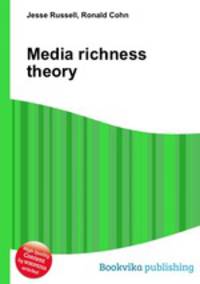Поиск книг, учебников, пособий в онлайн-магазинах

Media richness theory
Автор: Jesse Russell,Ronald Cohn, 113 стр., издатель: "Книга по Требованию", ISBN: 978-5-5088-7868-9High Quality Content by WIKIPEDIA articles! Media richness theory, sometimes referred to as information richness theory, is a framework to describe a communications medium by its ability to reproduce the information sent over it. It was developed by Richard L. Daft and Robert H. Lengel, and is used to rank and evaluate the richness of certain communication mediums, such as phone calls, video conferencing, and email. For example, a phone call can not reproduce visual social cues such as gestures, so it is a less rich communication medium than video conferencing, which allows users to communicate gestures to some extent. Specifically, media richness theory states that the more ambiguous and uncertain a task is, the richer the format of media that suits it. Based on contingency theory and information processing theory, it explains that richer, personal communication means are generally more effective for communication of equivocal issues than leaner, less rich media. Данное издание...
Рейтинг книги: 



 5 из 5, 2 голос(-ов).
5 из 5, 2 голос(-ов).




 5 из 5, 2 голос(-ов).
5 из 5, 2 голос(-ов).




